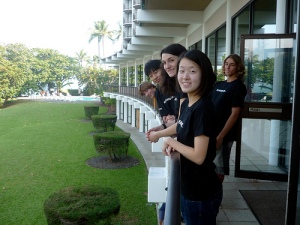Show 210 Listening Guide
 This week’s From the Top broadcast was taped at the Lunalilo Center at the Kamehameha School in Hilo, Hawaii on January 22, 2010. We asked our performers to tell us about the music they performed on the show:
This week’s From the Top broadcast was taped at the Lunalilo Center at the Kamehameha School in Hilo, Hawaii on January 22, 2010. We asked our performers to tell us about the music they performed on the show:
Lilia Xie, 16, flute
IV. Allegro con moto from Sonata for Flute & Piano, Op. 94 by Robert Muczynski
The fourth movement of Robert Muczynski’s Sonata for Flute and Piano reminds me a bit of a very angry Chihuahua. The flute is usually an instrument associated with sweet, pretty melodies, just as a Chihuahua is seen as a harmless lapdog. However, Muczynski uses strong rhythms, dynamic contrast, and the flute’s assertive high register to create a sense of brooding urgency. When I play this piece, I try to make sure that I convey the intensity so clearly that the listeners’ preconceptions of the flute’s capabilities become irrelevant, and I know from personal experience that a furious Chihuahua will make an unsuspecting person throw her previous generalizations of its harmlessness out the window.
Sean Robbins, 16, slack key guitar
Ku’u Ipo Onaona by Maddy Lam – Traditional
When I perform this piece, I think about Kalapana (a town on the south east side of Hawaii) because this is a song that I would call standard “Kalapana repertoire.” My favorite part of this piece is the bass run, which is also the hardest part of the piece because if one note is wrong it is really easy to hear.
Trifecta Trio
I. Presto from Trio for Oboe, Bassoon, & Piano by Poulenc
- Lauren Williams, 17, oboe: The Poulenc trio, for me, cannot be done justice without a concrete story in mind. Like all good stories, it is full of opposition in character and emotions. When I play this piece, I am reminded of a silent film. Since these films have no audible dialogue, the actors must exaggerate everything visibly, and I think the same goes for the performers of this piece. In order to keep the audience engaged and interested (and not confused), the performers must be incredible actors beyond, and without, the benefit of words.
- Frank Wu, 16, piano: This was the first piece that our ensemble ever worked on, and when I play this piece, I always think of the first rehearsal that we had. It was my first time ever playing chamber music, and I was trying to put together this tricky piece with people I had just met; you can imagine that it didn’t sound very good. As we got to know each other better, though, I think the overall playing has gotten much better.When I play this piece, the most important aspects I go for are dynamic contrast and passion in the expression because, to me, the beauty of this piece lies in the way the moods of the sections suddenly change along with the dynamics. It was these expressive elements that were the greatest challenges to our ensemble. We had to not only feel the music but also express it in coordination with one another.
- Quinn Delaney, 18, bassoon: I have never been in a very serious chamber group before, so almost everything about it is somewhat new to me. It may be difficult, but it is also the most fun I think I have playing music. It’s all about communicating with each other. Also, everything is so exposed in a trio, it’s like everything is solo.
Aris Doike, 17, cello
Requiebros by Gaspar Cassado
The style of this piece is unique and special compared to other pieces I have played. I want to show those listening to this piece the Spanish-like feeling that the music portrays. Being able to perform this piece musically with the right timing and rubato is probably the most difficult aspect of Requiebros. Although it is not the hardest piece technically, the musicality that the music demands is difficult to achieve.
Evan Lin, 14, piano
IV. Vivace from Sonata No. 2 in D Minor, Op. 14 by Sergei Prokofiev
This is one of the most exciting pieces I’ve learned so far. When I play this piece, I imagine that it is a thunderstorm. I rarely play the whole song perfectly, but in my opinion, that’s not what it takes to make this song exciting and sound good.




